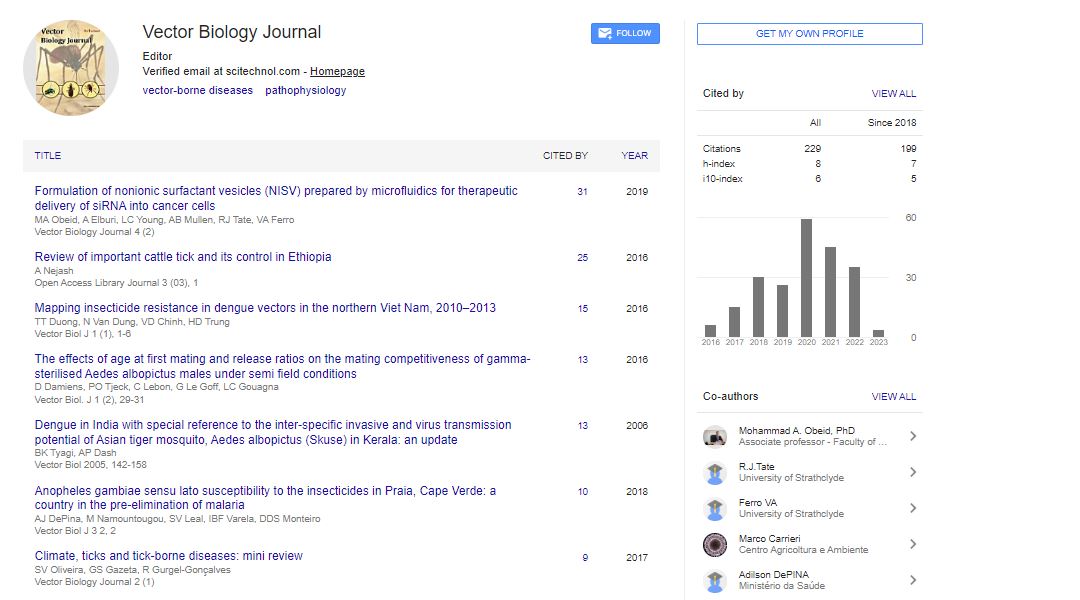Perspective, Vector Biol Vol: 8 Issue: 2
Importance of Reservoir Competence: Its Challenges and Future Directions
Daniel Carlson*
1Department of Biology, Indiana University, Bloomington, USA
*Corresponding Author: Daniel Carlson,
Department of Biology, Indiana
University, Bloomington, USA
E-mail: carl_sondaniel9097@uey.edu
Received date: 29 May, 2023, Manuscript No. VBJ-23-107345;
Editor assigned date: 02 June, 2023, PreQC No. VBJ-23-107345 (PQ);
Reviewed date: 16 June, 2023, QC No. VBJ-23-107345;
Revised date: 23 June, 2023, Manuscript No. VBJ-23-107345 (R);
Published date: 30 June, 2023 DOI: 10.4172/2473-4810.1000270.
Citation: Carlson D (2023) Importance of Reservoir Competence: Its Challenges and Future Directions. Vector Biol 8:2.
Description
Reservoir competence is a critical concept in the field of infectious diseases and epidemiology. It refers to the ability of a host species to maintain and transmit a pathogen to other susceptible hosts, including humans. The study of reservoir competence helps us understand the dynamics of disease transmission, identify high-risk populations, and develop effective control strategies. In this note, we will explore the concept of reservoir competence, its importance in disease ecology, and its implications for public health.
Reservoir competence can be defined as the capacity of a host species to serve as a reservoir or a source of infection for a specific pathogen. It depends on several factors, including the host's susceptibility to infection, the pathogen's ability to replicate within the host, and the host's potential to transmit the pathogen to other hosts. Hosts with high reservoir competence are capable of maintaining the pathogen's life cycle and perpetuating its transmission within a population.
Reservoir competence can vary across different host species. Some hosts may be highly competent, meaning they are efficient at transmitting the pathogen and play a significant role in its maintenance and spread. Other hosts may have low or partial reservoir competence, where they can be infected by the pathogen but do not contribute significantly to its transmission.
Examples of reservoir competence
Reservoir competence is observed in various infectious diseases that affect humans. One classic example is the transmission of the Lyme disease bacterium (Borrelia burgdorferi). In this case, small mammals, such as mice and chipmunks, serve as reservoir hosts. Ticks acquire the pathogen from infected reservoir hosts and subsequently transmit it to humans during a blood meal. Without reservoir competence in the small mammal population, the Lyme disease pathogen would have a limited chance of survival and transmission.
Another example is the role of birds in the transmission of the West Nile virus. Certain bird species, such as crows and jays, are highly competent reservoir hosts for the virus. Mosquitoes acquire the virus by feeding on infected birds and can transmit it to humans and other animals. The reservoir competence of specific bird species plays a crucial role in the maintenance and spread of the virus within a region.
Importance of reservoir competence
Understanding reservoir competence is vital for several reasons:
Disease surveillance: Identifying and monitoring reservoir hosts allows public health authorities to track the presence and spread of infectious diseases. By focusing surveillance efforts on high-risk host populations, early detection and control measures can be implemented to prevent outbreaks.
Transmission dynamics: Reservoir competence helps us understand the patterns and mechanisms of disease transmission. It provides insights into how pathogens circulate within and between host populations, aiding in the development of targeted interventions to interrupt transmission pathways.
Risk assessment: Assessing reservoir competence helps evaluate the potential risk posed by certain host populations. It enables the identification of high-risk areas and groups that may require specific prevention and control measures.
Control strategies: Reservoir competence data guides the development of effective disease control strategies. By targeting reservoir hosts or interrupting their contact with susceptible hosts, transmission can be reduced or eliminated. This may involve measures such as vector control, vaccination campaigns, or public health education.
One health approach: Reservoir competence highlights the interconnectedness of human, animal, and environmental health. Many pathogens circulate among multiple species, and understanding their reservoir hosts is crucial for a comprehensive One Health approach to disease prevention and control.
Challenges and future directions
Studying reservoir competence presents challenges due to the complex ecological interactions involved. Factors such as host population dynamics, pathogen evolution, and environmental influences can influence reservoir competence. Additionally, identifying reservoir hosts and accurately assessing their contribution to transmission can be logistically and technically demanding.
Reservoir competence is a fundamental concept in the study of infectious diseases. It plays a crucial role in disease transmission dynamics and informs public health strategies for prevention and control. By identifying and understanding reservoir hosts, we can gain insights into the complex interactions between pathogens, hosts, and the environment. This knowledge is vital for mitigating the impact of infectious diseases and safeguarding human and animal health.
 Spanish
Spanish  Chinese
Chinese  Russian
Russian  German
German  French
French  Japanese
Japanese  Portuguese
Portuguese  Hindi
Hindi 